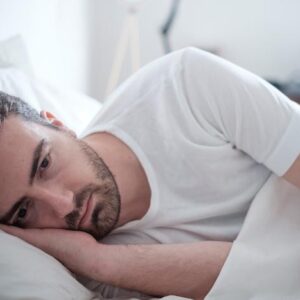Index
What is sleep apnea?
Synonyms : OSAS, obstructive sleep apnea, sleep breathing disorders
Sleep apnea is a sleep disorder that can be serious when breathing stops and starts again . People with obstructive sleep apnea may even be aware that they have the problem.
According to the Ministry of Health, about 18% of the population complains about the quality of sleep and 6% suffers from sleep apnea.
Types of idiopathic sleep apneas
There are two types of sleep apnea: Obstructive and Central.
Although another version could also be classified, which is mixed sleep apnea , but it would not have any substantial difference, it even really begins with a central apnea and ends up leading to an obstructive one, therefore a third type of apnea should not be considered .
Obstructive sleep apnea
It is the most common form, which occurs when the muscles in the back of the throat relax while the person sleeps the dream .
In obstructive sleep apnea, when these muscles relax, the airway is closed, which prevents and interferes with breathing. This can drastically lower the oxygen level in the blood , so the brain gets the message that something is wrong. Unable to breathe, you wake up from your sleep for a brief moment – in which your airways reopen and your breathing returns to normal. This problem, however, recurs numerous times during the night (five to thirty times an hour on average) and can cause serious complications.
During obstructive sleep apnea, a person may produce snoring or a choking-like sound. Irregular sleep prevents a person from achieving deep sleep, making them feel sleepy during the day.
Check out our article with 15 Essential Tips for a Peaceful and Restful Sleep .
Idiopathic central sleep apnea
Central sleep apnea is much less common and occurs when the brain stops transmitting signals to the breathing muscles .

A person suffering from this type of apnea may wake up short of breath or have difficulty sleeping, or even staying asleep. As with obstructive sleep apnea, here the person may also experience daytime sleepiness .
Causes of sleep apnea
Causes of Obstructive Sleep Apnea
For this type of sleep apnea, the main cause is the obstruction of the airways, situations such as obesity, the anatomy of the tonsils and the circumference of the neck can lead to sleep apnea.
Main causes of idiopathic central sleep apnea
The most common cause of central sleep apnea is heart failure and, rarely, a cerebrovascular accident (CVA).
Risk factors obstructive sleep apnea
Anyone can have sleep apnea, even children. Certain risk factors, however, are often listed by doctors and vary according to the type of disease, but at least two characteristics are common: being a man and being over 60 years of age.
Men, in general, are twice as likely to develop the disease as women, with a higher risk if they are overweight.
The main risk factors for obstructive sleep apnea are:
Overweight
The fat deposits around the upper airway can obstruct breathing , however, not all who have sleep apnea are overweight the so lean people can also develop the disease.
Neck circumference
People with a thicker neck may have narrower airways.
Narrowing of the airways
Some people naturally have narrow airways. There are also cases where the tonsils and adenoids (commonly known as vegetations) can become larger than normal as well, which can lead to airway obstruction.
Family background
People who have family members with a history of sleep apnea are at higher risk of having the problem.
Ethnicity
People of African descent are more likely to develop sleep apnea, especially those over 35 years of age.
Alcohol
The abuse of alcohol and substances such as sedatives and tranquilizers can relax the throat muscles.
Cigarette
The smokers are three times more likely to have obstructive apnea of sleep that people who have never smoked. Smoking increases the risk of inflammation and fluid retention in the upper airway.
Nasal congestion
If you have trouble breathing through your nose – whether it’s from a nasal problem, allergies, or a cold , for example – you’re more likely to develop obstructive sleep apnea.

Risk factors idiopathic central sleep apnea
As for central sleep apnea , the biggest risk factors are:
Heart disorders
People with atrial fibrillation or congestive heart failure are at increased risk for idiopathic central sleep apnea.
Stroke or brain tumor
A cerebrovascular accident (CVA) or the development of a brain tumor can damage the brain’s ability to regulate breathing, leading to central sleep apnea.
Symptoms of sleep apnea
Signs and symptoms of obstructive sleep apneas include:
- Hypersomnia (excessive daytime sleepiness)
- Loud snoring
- Waking up abruptly at night with shortness of breath
- Waking up with a dry mouth or sore throat
- Headache in the morning. More information on headaches: causes and treatments.
- Insomnia. More information on how to identify insomnia.
- Attention deficit
- Irritation, nervousness, and impatience during the day due to a sleepless night
- Be careless
- Migraines (headache difficult to treat). More information on primary headaches.
Seeking medical help
Consult a healthcare professional if you or someone you know exhibits these symptoms:
- Loud snoring
- Difficulty breathing during sleep
- Frequent pauses in breathing during sleep
- Excessive daytime sleepiness, which can cause a person to fall asleep during work hours or while driving.
Many people do not see snoring as a sign of a potentially serious health problem, and it is true that not everyone who snores has sleep apnea , but be sure to speak with a doctor if there is heavy snoring, especially if it is accompanied by periods be quiet.

Ask your doctor about other possible sleep problems that can also lead to symptoms such as fatigue, excessive sleepiness, and irritability.
Typical questions from the doctor and preparation for the consultation
The expert doctors who can only diagnose you sleep apnea and its types are:
- General clinical
- Otolaryngologist
- Pulmonologist
- Neuropsychiatrist
Prepare to try to help in the diagnosis and reduce the time in it . So it is convenient to go to the consultation with as much information as possible:
- Make a list with all the symptoms and how often they appear
- Recover your medical history, without missing other diseases that you have had or have, as well as medications and supplements of any kind that you take regularly. (This only if you do not go to your social security doctor in Spain, who have everything on your file)
The doctor will probably ask you some questions similar to the following:
- When did the symptoms start?
- Are the symptoms frequent? Do they occur every night?
- Have you been out of breath for a long time at night?
- How do you evaluate your nights of sleep?
- What position do you usually sleep in?
Sleep apnea diagnosis
Your doctor can make an evaluation based on your signs and symptoms, or he or she can refer you to a center that specializes in sleep disorders . There, a sleep specialist can help you identify the cause of the problem.
To make the diagnosis, your doctor may order a nighttime evaluation to monitor your body’s breathing and other functions during sleep. This test is called a nocturnal polysomnogram .
Night polysomnography
During this test, you fall asleep and stay connected to equipment that monitors the activities of the heart, lungs, and brain , and identifies a breathing pattern and movements of the arms and legs. The device also monitors oxygen levels in the blood.
Initial sleep tests
These usually involve measuring the heart rate, oxygen level in the blood pattern, air flow, and respiration. If you have sleep apnea, your test results will show a fluctuation in your oxygen level.
Sleep apnea treatments

Surgery may be an option in some cases. This may involve:The main goal of sleep apnea treatment is to keep the airways open so that breathing is not interrupted during sleep. Some patients may need to wear dental equipment in their mouth at night to keep the jaw positioned further forward and prevent airway obstruction.
- Surgical intervention in the cavity of the nose or spinal cord
- Surgery to remove tonsils and adenoids , which can cure the disease in children , but is not always effective in adults .
Today, inhalation with a continuous positive pressure air (CPAP) mask is considered a standard and effective treatment for obstructive sleep apnea in most people and the best thing is that it can be done. do at home . CPAP is applied by a machine with a mask on the face.
There is a special pillow that has a built-in CPAP hole, as you can see in the image above. Even so, these devices are generally expensive, but if you want the cheapest ones today you will find them in amazon, since an orthopedic takes a% greater benefits. Check it out for yourself, before you can try other cheaper solutions:
- ResMed S9 CPAP Standard Filter, 2pk by Sunset Medical by Sunset Medical
- CPAP – Memory Foam Pillow with Sleep Apnea Mask – Memory Foam, White, Medium
- CPAP AirSense 10 Elite – ResMed
- Philips Respironics CPAP mask (with clear frame and headgear)
- Resmed – AirFit P10 CPAP Mask, 3 Sizes, Blue
- Best Anti Snore Device Products on the Market – STOP SNORING Chin Strap – Comes with Sleep Aid Mouth Guard – Helps with Clenching, Grinding, Pain, Chattering – Best Dental Occlusal Guard – CPAP – Comfortable Relief Every Night – Money Back Guarantee!
- REMstar Plus 60 series CPAP – Philips Respironics
- CPAP S9 AutoSet
- Auto CPAP AirSense 10 AutoSet – ResMed
Prognosis in sleep apnea

Treatment for sleep apnea can and should be accompanied by lifestyle changes to relieve symptoms . Here are some tips:
- Avoid drinking alcohol and sedatives before going to bed
- Avoid going to sleep with a very full stomach or wanting to go to the bathroom
- Lose weight
Possible complications
Because of daytime sleepiness, people with sleep apnea are at increased risk of car accidents or falling asleep at work.
On the other hand, untreated obstructive sleep apnea can lead to cardiovascular disease, such as cardiac arrhythmia, heart failure, and hypertension. Other complications include:
- Sexual dysfunction
- Cerebrovascular accident (CVA)
- Endocrine and metabolic disorders
- Cognitive deficits.
Expectations
The symptoms of sleep apnea are usually completely corrected with treatment.
How to prevent developing sleep apnea
Anyone can develop sleep apnea, and many times there is no way around it . In other cases, however, some measures can be taken, such as:
- Lose excess weight
- Avoid alcohol abuse
- Stop smoking
- Use medications only on medical advice.
Kathie Sand always saw the world of beauty as the terrain on which to build her professional career, a goal that was clear to her when she was only 15 years old. Her great concern to expand knowledge led her to settle in Paris where she studied hand in hand with the best beauty professionals and with the most advanced techniques for skin care.



